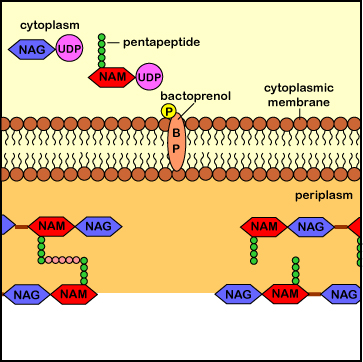
Peptidoglycan monomers are synthesized in the cytosol of the bacterium where they attach to a membrane carrier molecule called bactoprenol. The bactoprenols transport the peptidoglycan monomers across the cytoplasmic membrane and helps insert them into the growing peptidoglycan chains.
a. First, N-acetylglucosamine (NAG) links up with uridine diphosphate (UDP) to form UDP-NAG. Some of the NAG is enzymatically converted to N-acetylmuramic acid (NAM) forming UDP-NAM.
b. Five amino acids are sequentially added to the UDP- NAM forming a pentapeptide. The last two are D-alanine molecules enzymatically produced from L-alanine, the usual form of the amino acid.
c. The NAM-pentapeptide is attached to the bactoprenol carrier molecule in the cytoplasmic membrane, the energy being supplied by one of the high-energy phosphate groups of the UDP.
d. The NAG is attached to the NAM-pentapeptide on the bactoprenol to complete the peptidoglycan monomer.
Illustration of Synthesis of Peptidoglycan Monomers
and Action of Bactoprenol,
Step 1 .jpg by Gary E. Kaiser, Ph.D.
Professor of Microbiology,
The Community College of Baltimore County, Catonsville Campus
This work is licensed under a Creative Commons Attribution 4.0 International License.
Based on a work at https://cwoer.ccbcmd.edu/science/microbiology/index_gos.html.
Last updated: September, 2018
Please send comments and inquiries to Dr.
Gary Kaiser